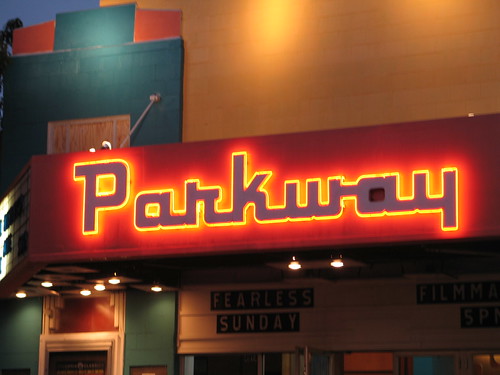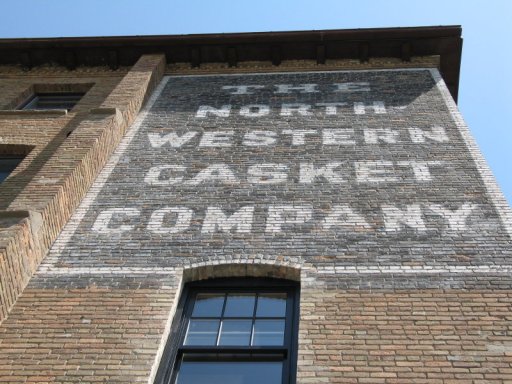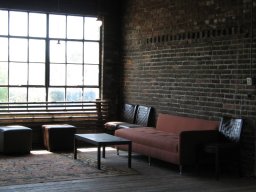By Teri Blair

Parkway Marquee, Minneapolis, Minnesota, September 2007, photo © 2008 by QuoinMonkey. All rights reserved.
In 1989 the Academy-Award winning Cinema Paradiso was released. The Italian film takes place in a post-World War II Sicilian village, and chronicles the friendship of a young boy, Toto, and the town’s gruff but lovable movie projectionist, Alfredo. Toto is fascinated by everything at the theater — the celluloid film, the projector, and the lion’s roaring mouth on the wall through which images pass from film to screen. We watch  Toto mature from mischievous child, to earnest young man, to successful filmmaker. But in-between scenes of first love and failing health and a changing Italian community, we see and know something else. We are witnessing the life of someone who is undeniably, unequivocally passionate about one thing — movies.
Toto mature from mischievous child, to earnest young man, to successful filmmaker. But in-between scenes of first love and failing health and a changing Italian community, we see and know something else. We are witnessing the life of someone who is undeniably, unequivocally passionate about one thing — movies.
Nineteen eighty-nine was also the year I began attending a theater in south Minneapolis that showed art house films, the sort of movies that weren’t on every screen in town. I rather stumbled upon the Parkway. There was a foreign film playing there that I hadn’t seen, and the theater’s recording said there was free lighted parking a block away. When I arrived, I knew I was at a theater that was different from any other in town. But what I didn’t know was that the theater was owned by someone who is undeniably, unequivocally passionate about one thing — movies.
Bill Irvine’s livelihood in the theater business began, like Toto’s, as a youngster. At thirteen, he was already an avid movie  enthusiast who saw at least one picture a week. One Thursday evening in spring, young Bill was walking by the Parkway Theater. The owner needed someone to change the marquee for the upcoming weekend movie. His regular marquee man hadn’t shown. Bill heard, “Hey kid! Do you want to make a buck?” He brought the ladder outside and put up the new film, Romeo and Juliet. He was paid a dollar, a Nut Goodie, and offered the same job the following Thursday. Before long he was working behind the candy counter, then selling tickets, and by the time he was a junior in high school, was managing the entire theater.
enthusiast who saw at least one picture a week. One Thursday evening in spring, young Bill was walking by the Parkway Theater. The owner needed someone to change the marquee for the upcoming weekend movie. His regular marquee man hadn’t shown. Bill heard, “Hey kid! Do you want to make a buck?” He brought the ladder outside and put up the new film, Romeo and Juliet. He was paid a dollar, a Nut Goodie, and offered the same job the following Thursday. Before long he was working behind the candy counter, then selling tickets, and by the time he was a junior in high school, was managing the entire theater.
That was 40 years ago. Last summer, the 53-year-old fixture at 48th and Chicago ended his career at the Parkway and turned over his theater keys to Joe Senkyr, owner of next-door Pepitos restaurant.
I caught up with Bill a few weeks ago. I wanted to hear his story. After all, who stays at a job for 40 years, let alone at one location? There is a boyish openness about Bill, a casual baseball hat, a ready smile. He was ready to talk, and as willing to divulge the hazards of his chosen profession as the rewards.
Bill never had a grand scheme to become an actor or a filmmaker himself. After high school he attended St. Thomas and Brown Institute to study Journalism and Broadcast Journalism. But at the young age of 20, he decided to make an offer on the up-for-sale Parkway. He knew the business inside and out, having already been an employee for seven years, and had no trouble getting several banks to offer him a loan to buy the place.
But instead of selling the theater to this neighborhood kid, then-owner Mel Lebewitz sold it to Jim Sparks, a man from Omaha who  specialized in porn theaters across the country…a move that mystifies Bill to this day. The community was outraged and months of demonstrations and picketing ensued. After six months of hassles, Sparks was ready to unload the Parkway, and Bill (still 20), bought it for $140,000 with his business partner Pat Nikoloff. Papers were signed in March of 1976, and six days later Bill opened with a double feature, The Pink Panther, and Bill Cosby’s Let’s Do it Again.
specialized in porn theaters across the country…a move that mystifies Bill to this day. The community was outraged and months of demonstrations and picketing ensued. After six months of hassles, Sparks was ready to unload the Parkway, and Bill (still 20), bought it for $140,000 with his business partner Pat Nikoloff. Papers were signed in March of 1976, and six days later Bill opened with a double feature, The Pink Panther, and Bill Cosby’s Let’s Do it Again.
Bill was quickly enfolded into the Twin City theater-owner community. It was a Jewish-dominated industry, and with a name l ike Irvine, Bill let himself pass for Jewish…even though his heritage is Scottish and English. “No one asked me, so I never told,” Bill laughs.
ike Irvine, Bill let himself pass for Jewish…even though his heritage is Scottish and English. “No one asked me, so I never told,” Bill laughs.
Bill’s outgoing personality lent itself to the business. He grew to know the stories of his customers’ lives, and they became his friends. He saw their children grow up, celebrated job promotions, and grieved a lost parent. And along with the relationships, he created a theater known for its documentaries, foreign films, and thought-provoking dramas.
“I have loved what I have done, and I am happy,” Bill mused. “If you don’t love your job, you start to hate life and become bitter and mean. If I were talking to a 25-year-old, I would tell them to set their sights high doing something they love, stick with it, and be good at it.”
The movie industry changed during the 40 years that Bill owned the Parkway. When he began, there were several one-screen theaters in town. They are now the rare exception, having given way to 10-and 20-plex theaters. “When I started in the business, actors were well-trained in their craft. Now, theaters are desperate to fill screens. The integrity of films has suffered, and most movies have no shelf life. If someone has an attractive face, they slap them up on the screen and call them an actor.”
But in the midst of this, Bill maintained a caliber of quality movies that brought his faithful customer base back week after week. He spent hours combing through sample DVDs to find good selections. “I think most people would be surprised by how time-consuming this job is,” he says. “It takes so much time to find a good movie.”
 Bill has his own personal favorites, of course: the documentary Brother’s Keeper, Waiting for Guffman, and Shawshank Redemption. The actors who top his list are Meryl Streep, Cate Blanchett, Woody Allen, and Michael Caine. The longest-running movie in Parkway’s history was Shirley Valentine, the story of a woman who flees her stale life in England to begin again in Greece. It stayed at the Parkway for 38 weeks.
Bill has his own personal favorites, of course: the documentary Brother’s Keeper, Waiting for Guffman, and Shawshank Redemption. The actors who top his list are Meryl Streep, Cate Blanchett, Woody Allen, and Michael Caine. The longest-running movie in Parkway’s history was Shirley Valentine, the story of a woman who flees her stale life in England to begin again in Greece. It stayed at the Parkway for 38 weeks.
What is next for Bill? “Well, I’d like to travel. I want to see New Zealand and Australia. I may open up another theater in St. Cloud or St. Paul; I’ve had a job offer from Columbia Film Society in South Carolina. But I haven’t really decided.”

Blueprint, Minneapolis, Minnesota, September 2007, photo © 2008 by QuoinMonkey. All rights reserved.
And how about the Parkway? New owner Senkyr has already begun major renovations: a newly exposed balcony railing, rich colors and murals, seats torn out to make room for a larger stage for live theater. Weekly changes are quickly making the old Parkway harder to remember as the new one is born.
And what about us, those of us who look first at what is playing at the Parkway when we open up the movie section? We likely won’t find another movie theater where the owner calls us by name when we walk through the door, where we can ask for a glass of water and not be charged for it, and where our business is so clearly appreciated.




I have never minded that there were some lumpy seats and peeling paint on the ceiling. Because the Parkway has maintained something that is hard to come by these days — a sense of belonging and community. In a big city we have had a place that has felt a little like a small town. A place where we could enjoy the talent of someone who knew his business and the quality of films never diminished. A place where the popcorn was always fresh and the movies ever enchanting.
We have been lucky. We have gotten to be a part of a Bill’s 40-year love affair. A love affair with the movies.

Parkway Lights, inside the Parkway Theater, Minneapolis, Minnesota, September 2007, photo © 2008 by QuoinMonkey. All rights reserved.
Teri Blair is a freelance writer living in Minneapolis. She is currently writing a profile series on teachers who taught in one-room rural schools before, during, and after WW II. They are appearing monthly in Senior Perspective.
About profiling, Teri says: I stumbled onto profiling quite by accident. I owned a dairy barn that had been a dance hall during the Depression, and I wanted to meet people who had danced there. When I heard their stories, it was obvious they had to be recorded. One thing quickly led to another, and before long I had a series of essays on my hands that people wanted to read.
I typically go into an interview with 10 questions, one tape recorder, and two cameras. I’ve learned through many fits and starts how to adapt questions, change directions, and let the real story emerge. I’ve had two tape recorders break during interviews, several rolls of film come back blurry, and been in situations where I was so nervous I could barely keep from passing out. I’ve also had the time of my life…adventures worth their weight in gold.
Profiling gives me the chance to shine lights on people who deserve attention for adding something of value to our world. That is my greatest reward.
Favorite profile experience to date: After interviewing a 14-year-old musher, he took me on an invigorating dogsled ride through ditches, woods, and down snow-covered gravel roads. I learned that a 14-year-old boy has only one speed he is interested in: FAST.



About the photography: All the photographs were taken on September 20th, 2007 by QuoinMonkey during an Ani DiFranco poetry reading at the Parkway Theater in Minneapolis. She would later find out, the timing occurred shortly after Bill Irvine transferred ownership of the Parkway Theater. The seeds for a collaboration between Teri’s profile and the Parkway photographs were planted in a Comment thread on The Brave One. The result is this chance meeting between language and the visual.
Read Full Post »


































































